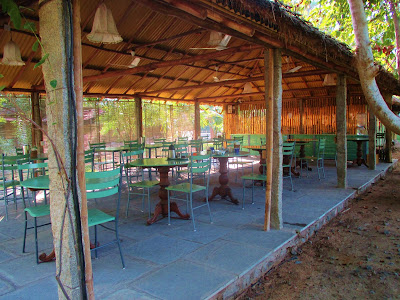It was built at the zenith of Vijayanagara architecture in 1509 -1529 although the core was 100 years earlier.
It is dedicated to Lord Vitthala, an incarnation of Lord Vishnu.Three gopuras tower over the central courtyard on three sides.
The stone chariot is in fact a shrine to Garuda the sacred bird which transported Lord Vishnu. As can be seen from the mid nineteenth century photo the shrine originally had an ornate tower which has since disappeared. The stone wheels were designed to turn but have now been fixed to preserve the mechanism. The disproportionate elephants were a later addition, originally there were horses which must have been victims of the destruction in 1565.
An interesting photograph take in 1856 by amateur British colonial photographer, Alexander Greenlaw who was the first to extensively photograph in 1855- 56.
The intensity of stone carving is wonderful, all the pillars in the various mandapas have carved plinths with a huge variety of subjects, sacred and profane. Below are Krishna with traces of the original painting which adorned the temples, a rare carving of Ravana, armed men on a mythical creature, tiger legs, horse body, hare ears and lion head, a drummer rapt in his music.

There was a spectacular view over to the other side of the rive and the Anjanadri Hill with the 575 steps up to the Hanuman shrine, yet to be untaken.
After leaving the serene atmosphere of Vitthala, we continued our walk along the river past goatherds, pilgrim shelters,coracle crossings, sugarcane juice vendor and a sacred tree festooned in rag bundles enclosing pebbles, each pebble is wish for a child and beneath the tree were crudely made miniature shelters, desires for a home.
We climbed a hillside, an unbroken expanse of granite with some ancient carvings,worn steps led to the top where we were to take a tuc tuc ride on to the Palace of Vira Harihaha .
A distant view of the stunning gopura of the Virupaksha temple to be visited tomorrow.
Not much left of the Palace of Vira Harihaha which dates from 1377 - 1404 but from the remaining foundations it must have been a magnificent sight, the secular part of the sacred city. The most well preserved area is the zenana, womens quarters. It is surrounded by tall protective walls, still intact, huge asymmetrically cut rocks laid with great precision, there are three remaining watch towers and at the back of the area are the elephant stables but the miraculously intact wonder is the Lotus Mahal. Thought to be a summer retreat for the royal ladies, it was originally surrounded by a moat, there was a pumping system through terracotta pipes inlaid into the walls which had a cooling effect in the intense heat of summer. All the remaining buildings are in the Indo-Islamic style of the 16th century.
On leaving the zenana we stopped for yet another coconut juice, the most refreshing thing in the world after a hot sticky day of being intense tourists. Just by the coconut juice vendor was a very special entwining of two of the most sacred trees, a Peepul also know as Bodhi, the tree of enlightenment and a Banyan, tree of life. Underneath these especially auspicious trees were several shrines with smashed coconuts and flowers as puja offerings.






















































